The demand for cold-chain logistics worldwide is growing. Chris Anderson looks into how airports are meeting cargo clients’ ever-increasing needs
According to a report last year from market researcher Fortune Business Insights, the global cold-chain logistics market is predicted to be worth around US$647.47bn by 2028. It was previously valued at $221.85bn in 2020, and at $242.39bn in 2021, so the projected growth here is staggering.
A number of reasons are thought to be behind this increasing popularity. One is that the effective transportation of temperature-controlled products, via a supply chain using refrigerated packaging solutions, preserving the quality of food and pharmaceuticals, for example, minimises waste. There is less degradation of food quality en route, meaning that less is thrown away.
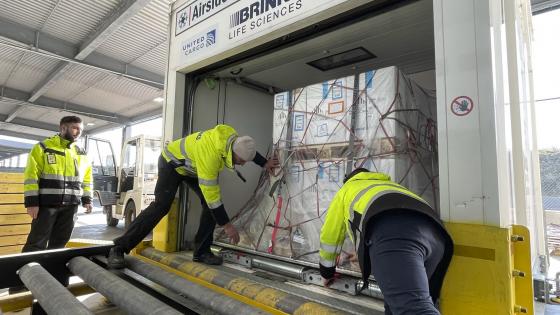
The Airside Pharma Transporter at Brussels Airport uses solar power technology to operate autonomously
In addition, increasing government initiatives and subsidies have enabled cold-chain providers to tap into developing markets such as India, Japan and Canada, with innovative solutions to make the refrigerated transportation of difficult or unusual items easier. And the rise of e-commerce has boosted demand for perishables, such as fast-food delivery services, thus creating even more opportunities for the cold-chain market.
In the case of pharmaceuticals, clearly a spotlight has landed on cold-chain solutions as a result of the COVID-19 pandemic. Vaccines need to arrive in countries at controlled temperatures to maintain the desired effect, which means an effective cold-chain needs the right equipment and technology, trained staff, and efficient planning. Even the slightest error can have a devastating effect, resulting in a spoiled shipment.
You might think beer and chocolate were the biggest exports from Belgium, but it’s actually pharmaceuticals
Airports have the edge
Airports are one of the gateways that perishable goods can find themselves travelling through, and are always looking to grow and improve their cold-chain offering. Here Michael Zach, vice president of sales, finance and cargo at Vienna International Airport, explains how his own place of work handles products: “With the Vienna Airport Pharma Handling Center, we actually have our own dedicated facility to handle temperature-sensitive goods, especially pharmaceuticals and biotech products,” he told Airports International. “It has two large-scale cooling warehouses, offering storage at either 2-8°C or 15-25°C, with mobile refrigeration to ensure safe connections between the air and land sides. And we have our state-of-the-art temperature-monitoring systems and CCTV, ensuring everything is transported exactly as it should be.
“COVID-19 has definitely led to a surge in the demand for cold-chain services. In 2022, we handled more than 3,600 tonnes of temperature-sensitive goods, which was a 64% rise on the previous year, and 173% up on 2019. Due to its speed and efficiency, air cargo will always be the preferred choice over land for transporting such materials.”
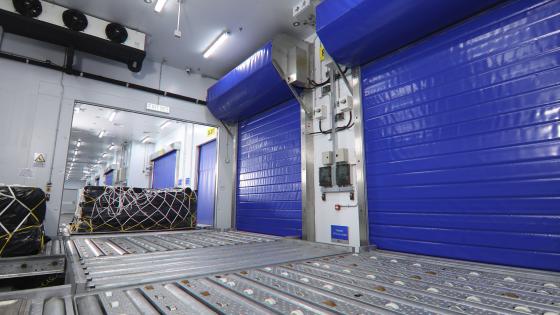
Lödige Industries created an automated cold chain pallet-cargo system for AAT Coolport at Hong Kong International Airport
Samuel Speltdoorn, cargo business development manager at Brussels Airport, agrees that perishables, in general, is a huge market. “We see flowers and vegetables from South America and Africa come via the airport, and the growth in e-commerce is also having an effect,” he said. “And you might think beer and chocolate were the biggest exports from Belgium, but it’s actually pharmaceuticals, around 20 times bigger – Belgium is third globally for pharmaceuticals, behind the US and India. So for a long time, before COVID, we’ve been heavily investing in our cold-chain cargo facilities at Brussels Airport, with dedicated warehouses, airside pharma transporters, special equipment and processes. We speak directly with the pharmaceutical companies, and meet regularly, to make sure we’re able to cater to what they need.
“We have 35,000m² of dedicated pharmaceutical cold-chain warehousing available, which is among the largest in the world for an airport. What we need to do now is optimise the landside to airside transfer, which we’re currently working on. That’s the question we’re always asked: how can we shorten the time between the warehouse and the aircraft for pharmaceuticals? That could mean dedicated pharma facilities on the air side, or specific conveyor belt systems. There are lots of ideas.”
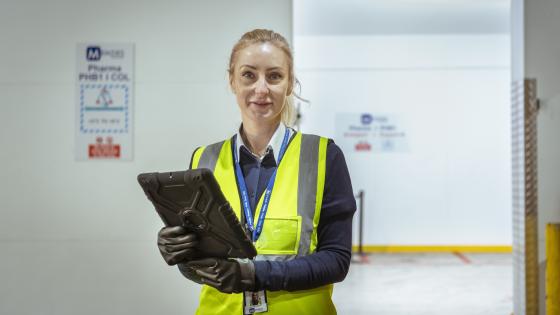
Increasing digitalisation of processes means that it is not unusual to see cargo staff using tablets
Expert opinions
Airports will lean on the knowledge of specialist companies to keep up-to-date in terms of the latest cold-chain technology. Among them is Lödige Industries – a supplier of automated guided vehicles (AGV), transporter lifts, truck docks, caster decks, multi-level storage systems and many more industry-specific solutions. Björn Ussat, director airport logistics solutions, explained what airports will need to offer in cold-chain terms.
“For highly-sensitive goods, fast and precise processes, as well as complete documentation, are crucial to ensure seamless cold-chain operations.
“Segregation requirements must also be taken into account when planning the unit load device (ULD) cold storage rooms in the warehouse to avoid cross-contamination. We always tailor the various infrastructure elements to the different sizes and process types of the airport terminals, ensuring fast handling, and the best possible use of the available space,” Ussat said.
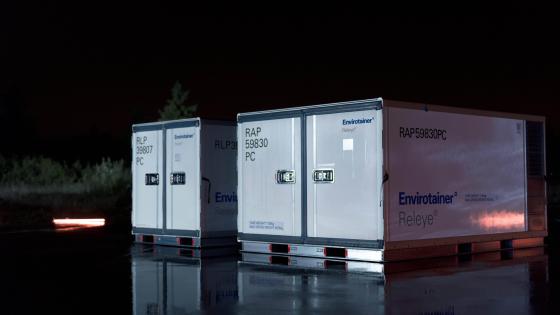
The largest of the new-generation Releye containers, the Releye RAP holds five Euro pallets
Menzies Aviation, based in Edinburgh, is another company offering a variety of services to airports, including cold-chain storage, and Alan Glen is its vice president of cargo development. “We’ve grown rapidly in the last few years, and now have 75 locations globally, with varying cold-chain capabilities in each,” he told Airports International. “We also have several new warehouses in development to cater to market demand, and always include cold-chain requirements in the initial development stages to make sure they benefit from the optimum position to maintain the desired process, and have the necessary power supply.”
Envirotainer is a leading supplier of active cold-chain solutions, meaning it offers electronically-controlled cooling systems or dry ice in its containers (passive solutions are insulated boxes with no active temperature controls). It has also seen demand rise, as COO Niklas Adamsson observes. “Our fleet covers more than 2,000 pharmaceutical trade lanes in more than 100 countries and 300 airports, and we’re looking to increase our fleet of 7,500 containers by another 1,300 in 2023,” he said. “Recent innovations have included the new CryoSure station in Singapore, offering ultra-cold transportation for medicines at -70°C. We have CryoSure dewars, or vacuum flasks, perfect for storing clinical trials, vaccines, biospecimens, and more.”
People favour bigger, better solutions [that are] cost-effective and sustainable, and these are the factors driving the market
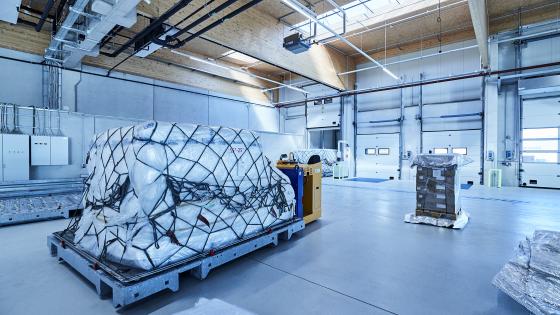
The cooler of two large-scale cooling warehouses at VIE offers storage at 15-25°C
New technology
As well as the equipment required to make a cold-chain system effective, the technology used can also improve efficiency. “It’s important to seamlessly document all cold-chain processes, which we ensure with a comprehensive CCTV and sensor system, as well as our new cloud data system,” Vienna Airport’s Michael Zach told us.
For Samuel Speltdoorn at Brussels Airport, new technology is being considered as a way to increase its offering. “Cell and gene therapy is something we could be moving into, as an extension of our work with the pharmaceutical companies,” he said. “We have to understand the needs of transporting these advanced treatment sets, as it’s not a generic treatment like we’re used to, and it’ll be a case of dealing with smaller incubators. So we’re advising on the type of packaging, or what traceability might be needed.”
Menzies Aviation’s Alan Glen is always looking to technology to make improvements to the existing processes. “As an industry, we need to take advantage of technology to continuously monitor temperatures in shipments,” he says. “This would require data-sharing between parties, and while we’re making progress, there’s still some way to go before it’s the norm.”
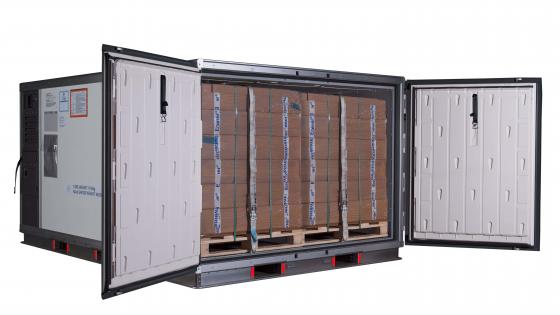
The Releye RLP container features integrated live monitoring which enables a unique insight into product condition, location and progress of the shipment
At Envirotainer, technology is used to make more efficient storage. “Our most advanced container, the Releye, launched in 2021, and was created with control, monitoring, autonomy, value and sustainability in mind,” said Niklas Adamsson. “We’re talking giant, battery-powered, insulated units, with up to five pallets of pharmaceuticals loaded into them, maintaining a constant internal temperature for up to a week.”
Lödige Industries is also making good use of the latest technology, from automated vehicles to state-of-the-art storage systems, in its latest cargo terminal designs. “These can independently and flexibly connect different areas, such as import/export and build-and-break work zones,” said Björn Ussat. “Depending on the size and level of the automation required in the cool storage area, we make use of various roller decks, conveyors or transfer vehicles for transport, as well as storage and retrieval systems.”
“AGVs, for example, can independently and flexibly connect different areas, such as import/export and build-and-break work zones, providing an automation solution for areas of all sizes,” he added.
Monitoring demand is also important, so we don’t have cold rooms sitting empty, using energy unnecessarily
Going green
Cooling systems can be quite energy-intensive, so is there a way to make the cold-chain processes as sustainable as possible? “We’re always looking to make our operations throughout the airport more environmentally-friendly, not just our cold-chain facilities,” explained Vienna Airport’s Michael Zach. “Last year, we commissioned the largest photovoltaic (PV) system in Austria, converting sunlight into electrical energy, which will cover all of the energy demands of the airport. Our fleets of airport vehicles are being converted to run on electric, and we use LED lamps and energy-efficient building insulation. Since 2012, the airport has already reduced its carbon emissions by around 85%.”
The story is similar at Brussels Airport, where environmental upgrades are not limited to cold-chain facilities. “We’re electrifying our vehicle fleets, and looking at hydrogen energy,” said Samuel Speltdoorn. “And we have a lot of old buildings from the 1970s and 1980s that need upgrading, with better insulation, and a change over from fossil fuels, using more solar panels. Optimising processes, with monitoring, using digitalisation and IoT [Internet of Things], will also help our carbon footprint.”
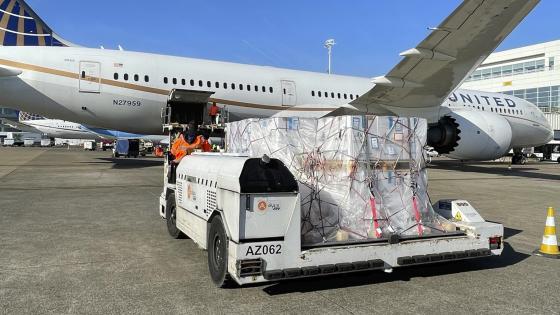
One billion COVID-19 vaccines were shipped through Brussels Airport between November 2020 and March 2022
Alan Glen at Menzies Aviation agrees that this is not purely a cold-chain issue. “Yes, cold rooms can use a lot of energy,” he said, “and we do have facilities where solar energy is utilised. But monitoring demand is also important, so we don’t have cold rooms sitting empty, using energy unnecessarily.”
Niklas Adamsson at Envirotainer has other ideas. “Is it possible to use packaging with a lower environmental impact?” he asked. “Keeping a pallet of treatments at low temperatures for an entire journey traditionally requires lots of single-use plastics and coolants. Choosing to work with partners that prioritise sustainability can also make a difference.”
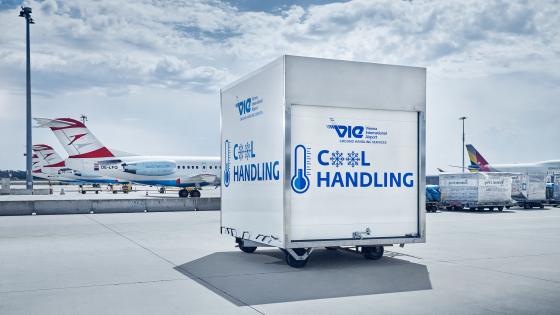
Pharma logistics at Vienna are directly connected to air facilities, with very short tarmac distances to aircraft
Addressing the challenges
Clearly an efficient cold-chain model, transporting vulnerable goods as seamlessly – and ideally, as sustainably – as possible is the goal for all involved. But what challenges can arise, and how are they dealt with? “Planning and implementation is always key, and with Vienna Airport operating both its own cargo handler and pharmaceutical centre, it reduces the margin for error, as everything stems from a single source,” Michael Zach said. “We have lots of handling and storage capacity, so there are no traffic jams or delays that could affect the handling of temperature-sensitive cargo.
“It’s always a real test of a good logistics infrastructure in the headwinds of global events, such as the pandemic or the war in Ukraine. During COVID-19, we adapted quickly, with many additional cargo flights, and even spontaneous charter flights, with the handling of temperature-sensitive goods running without delays. With the war in Ukraine, you can get sudden cargo cancellations to Asia at short notice, as Russian carriers like Air Bridge Cargo have suddenly dropped out, but we’ve managed to adapt to this too.”
The situation in Ukraine has had similar repercussions at Brussels Airport. “Some airlines – which flew in from Japan across Russia – have temporarily dropped out,” said Samuel Speltdoorn. “But currently, there’s also a general global market decline, with buying power a little weaker in the wake of the pandemic. This can be taken advantage of, though, as a time to reassess, develop new processes, and prepare for the market picking up.”
Cargo hubs experienced congestion [as result of the war in Ukraine], as shipments were stopped by embargoes, bans and reduced services
Niklas Adamsson at Envirotainer talks about the specialist nature of cold-chain equipment, and states one of the challenges as ensuring staff fully understand the task at hand. “We provide our Academy courses to educate and train operators on best practice for the safe delivery of pharmaceuticals,” he explained. “This is something offered free of charge, and our programme has a long tradition, helping thousands of cold-chain stakeholders, from ground handlers to manufacturers, develop their skills to meet the requirements of an increasingly-demanding regulatory landscape.”
Adamsson also highlights the growing demand, and the logistics involved in meeting it, as a challenge in itself. “Medicines are needed everywhere around the world, and so are our temperature-controlled containers,” he added. “We have more than 60 stations across the globe to cater to customers in need of a secure transportation of temperature-sensitive pharmaceuticals. In general, people favour bigger, better solutions, cost-effective and sustainable, and these are the factors driving the market.”
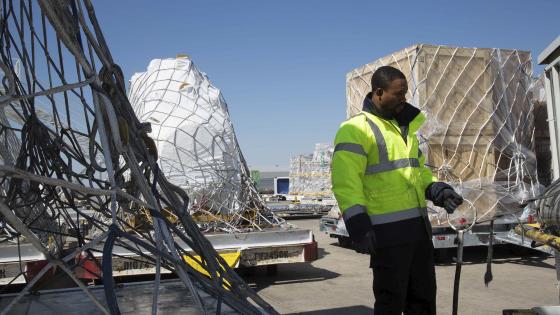
Menzies continues to focus on achieving CEIV Pharma certification across its bases
And, of course, there is Ukraine presenting its own share of difficulties. “When the conflict escalated in 2022, many shippers were caught off guard,” admitted Adamsson. “As a result, cargo hubs experienced congestion, as shipments were stopped by embargoes, bans and reduced services. Rerouting cargo that was already in transit was also a challenge, because the packing and labelling requirements for the Russian market are very different from those in most other places.
“The economic war between the West and Russia as a result of the invasion has further complicated matters for the air cargo sector, as we now have air-space restrictions. Because civilian flights over Ukraine are not allowed, and airlines are avoiding Russian air space, freight rates have increased considerably. However, now that the initial shock is over, we are seeing prices slowly returning to normal. Nevertheless, shippers still have to take alternative and longer routes, which means that the cost of fuel remains high.”
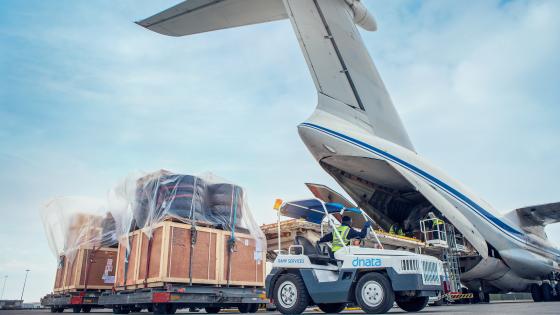
dnata recently commissioned Lödige Industries to develop a new cargo terminal at Amsterdam Airport Schiphol
Seeing potential
As exciting as the cold-chain logistics market seems to be at present, with ever-increasing demand and plenty of opportunity for airports, stakeholders need to bear in mind the various challenges. This includes those within their control, such as forging close relationships with customers and investing in the latest technology, and those outside, including global events, not least the war in Ukraine.
Providers and airports should also gauge the market carefully. Recent reports suggest that available air cargo capacity increased for the 11th consecutive month in February, surpassing 2019 levels for the first time, just as the actual demand dropped 4% year on year, with shippers looking for cheaper modes of transportation. This reflects Samuel Speltdoorn at Brussels Airport’s comments that any slowdown can be used to prepare for the market’s return.
Regulations, as with the different requirements between locations, should also be carefully considered. But overall, there could be ample potential for airports and providers when it comes to cold-chain cargo. Very cool indeed.
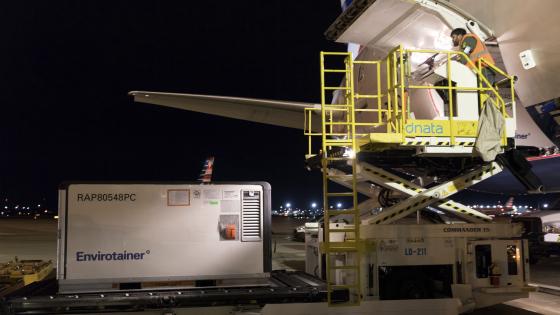
Cautious optimism seems to be the mood of the day among cold-chain cargo stakeholders
Need to know more: Cargo and the cloud
Cold-chain cargo providers and airports are increasingly using cloud technology to increase the transparency, efficiency and competitiveness of their services. Brussels Airport even offers its own cargo system, BRUcloud, and its applications, to other airports as a revenue stream.
Similar is happening at Vienna Airport. “Since the end of 2021, our Vienna Airport Pharma Handling Center has been able to upload all relevant data to an internet cloud,” said the Austrian hub’s vice president of sales, finance and cargo, Michael Zach. “This facilitates documentation, and enables a transparent overview, which optimises the planning and analysis of our customers’ cold chains.”
Likewise, Menzies Aviation has teamed with a provider called Wipro. “It’s part of a new warehouse management system, architected using cloud-native technologies,” explained Menzies’ Alan Glen. “It enables the end-to-end digitalisation of our operations, process standardisation, and enhanced employee experience, which is hugely important in attracting a new generation of cargo professionals. Our customers benefit from the increased transparency of cargo status, the use of automation to speed up processes, and enhanced safety and security procedures. It will also enable us to adopt future technologies with ease.”
For Envirotainer, the transportation of pharmaceuticals is a highly-regulated and sensitive operation, so involving the cloud gives customers more control and reassurances. “They want monitoring to ensure there is no temperature deviation, no tampering with their cargo, and to assist with investigations,” said COO Niklas Adamsson. “They also need autonomy, to allow for delays and challenges, with an air freight system under pressure. We have our cloud-based Control Tower assisting a global team of operators.”
Need to know more: Effective storage
Cold-chain cargo systems at airports need effective storage solutions, not only capable of maintaining temperature-sensitive goods but managing to deliver and retrieve items as quickly and seamlessly as possible, as even just the slightest delay or exposure to the wrong temperatures can render the products worthless. For this reason, airports are always looking to upgrade their pallet systems to the latest, most efficient designs.
Lödige Industries was recently tasked with creating a new cargo terminal at Amsterdam Airport Schiphol on behalf of air services provider dnata, set to become operational next year, as well as an automated cold chain pallet-cargo system at Hong Kong International Airport. “From special temperature-controlled truck docks and dolly docks, to electrically-driven transport systems for containers and pallets, such as the slave pallet mover, to workstations that allow the ergonomic build-up and break-down of cargo, these are both typical of the wide range of systems we offer for handling and transportation in a fully temperature-controlled environment,” the company’s Björn Ussat explained. “Automated guided vehicles (AGVs) can also be integrated for completely automated ULD transport.”
Secure cold-chain solutions provider Envirotainer developed a world-first with its Releye RAP containers, which hold five Euro pallets. With their increased efficiency and capacity, the containers help to reduce the carbon emissions per shipment.
Brussels Airport has also been looking to improve its capacity and efficiency. “We have automatic ETVs (Electric Track Vehicles) and pallets, which transport the pharmaceuticals into a waiting system, ready for flights,” said the airport’s Samuel Speltdoorn. “We’re always trying to optimise our processes.”
